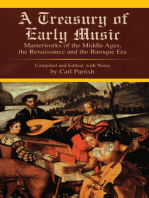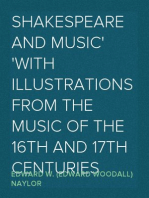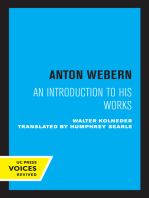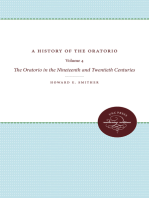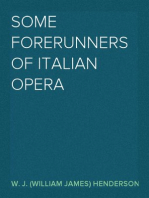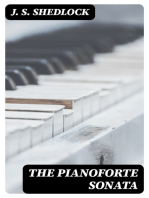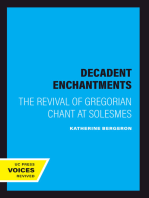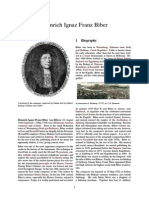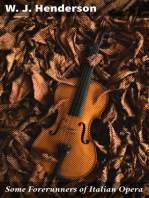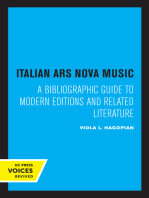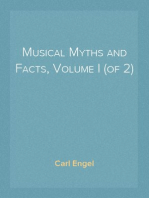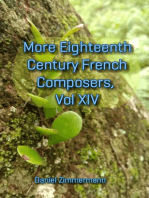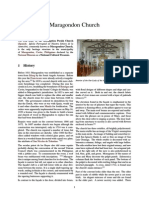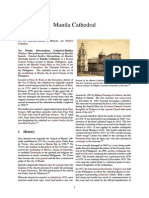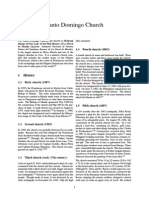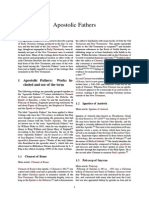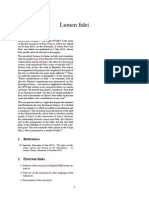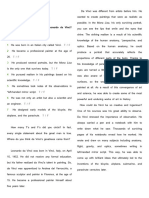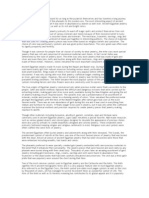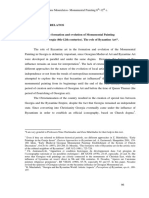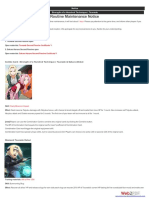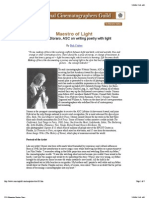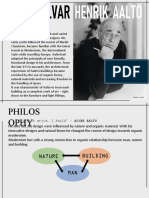Documentos de Académico
Documentos de Profesional
Documentos de Cultura
Gregorio Allegri: 2 The Miserere
Cargado por
Jason TiongcoTítulo original
Derechos de autor
Formatos disponibles
Compartir este documento
Compartir o incrustar documentos
¿Le pareció útil este documento?
¿Este contenido es inapropiado?
Denunciar este documentoCopyright:
Formatos disponibles
Gregorio Allegri: 2 The Miserere
Cargado por
Jason TiongcoCopyright:
Formatos disponibles
Gregorio Allegri
one of the earliest composers for stringed instruments,
and Athanasius Kircher has given one specimen of this
class of his works in his Musurgia. Most of Allegris
published music, especially the instrumental music, is in
the progressive early Baroque concertato style. However,
his work for the Sistine Chapel is descended from the
Palestrina style, and in some cases strips even this rened,
simple style of all ornament. He is credited with the earliest string quartet.
2 The Miserere
Main article: Miserere (Allegri)
By far the most well known and regarded piece of music
composed by Allegri is the Miserere mei, Deus, a setting
of Vulgate Psalm 50 (= Psalm 51). It is written for two
choirs, the one of ve and the other of four voices, and has
obtained considerable celebrity. One of the choirs sings a
simple fauxbordon based on the original plainsong chant
Gregorio Allegri
for the Tonus peregrinus; the other choir sings a similar
fauxbordon with pre-existing elaborations and the use of
Gregorio Allegri (c. 1582 7 February 1652)[1][2] was cadenzas. The Miserere has for many years been sung anan Italian composer of the Roman School and brother of nually during Holy Week in the Sistine Chapel. Many
Domenico Allegri; he was also a priest and a singer. He have cited this work as an example of the stile antico (old
was born[3] and died in Rome.
style) or prima pratica (rst practice). However, its constant use of the dominant seventh chord and its emphasis
on polychoral techniques certainly put it out of the range
of prima pratica. A more accurate comparison would be
1 Life
to the works of Giovanni Gabrieli.
He studied music as a puer (boy chorister) at San Luigi
dei Francesi, under the maestro di capella Giovanni
Bernardino Nanino, brother of Giovanni Maria Nanino.
Being intended for the Church, he obtained a benece
in the cathedral of Fermo. Here he composed a large
number of motets and other sacred music, which, being
brought to the notice of Pope Urban VIII, obtained for
him an appointment in the choir of the Sistine Chapel at
Rome as a contralto. He held this from 6 December 1629
until his death. As Andrea Adami wrote, Allegri was regarded as singularly pure and benevolent.[4]
The Miserere is one of the most often-recorded examples
of late Renaissance music, although it was actually written during the chronological connes of the Baroque era;
in this regard it is representative of the music of the Roman School of composers, who were stylistically conservative. The work acquired a considerable reputation for
mystery and inaccessibility between the time of its composition and the era of modern recording; the Vatican,
wanting to preserve its aura of mystery, forbade copies,
threatening any publication or attempted copy with excommunication. They were not prepared, however, for a
special visit in 1770 from a 14-year-old named Wolfgang
Amadeus Mozart, who, on a trip to Rome with his father,
heard it but twice and transcribed it faithfully from memory, thus creating the rst known unauthorised copy.[5]
Among Allegris musical compositions were two volumes
of concerti for ve voices published in 1618 and 1619;
two volumes of motets for six voices published in 1621;
an edition of a four-part sinfonia; ve masses; two settings of the Lamentations of Jeremiah; and numerous In 1771 Mozarts copy was procured and published in
motets which were not published in his lifetime. He was England by the famous traveler and music historian Dr.
1
Burney. However, Burneys edition does not show the
ornamentation for which the work was famous. The music itself is rather basicchurch music at the time placed
a large gap between written and performance practice
embellishments were largely placed in the hands of the
performers tastes, although the Vatican score itself was
altered largely by performers and visitors over the years.
The music as it is performed today includes a strange error by a copyist in the 1880s. The curious truckers gear
change from G minor to C minor is because the second
half of the verse is the same as the rst half, but transposed up a fourth. The original never had a Top C.[6]
The entire music performed at Rome in Holy Week, Allegris Miserere included, has been issued at Leipzig by
Breitkopf and Hrtel. Interesting accounts of the impression produced by the performance at Rome may be found
in the rst volume of Felix Mendelssohn's letters and in
Miss Taylors Letters from Italy.
References
[1] Gregorio Allegri classical.net, 2013. Retrieved 2 September 2013.
[2] 1911 Britannica gives year of birth as 1560 or 1585 and
death as 18 February 1652.
[3] Allegri, Gregorio in Chamberss Encyclopdia. London: George Newnes, 1961, Vol. 1, p. 271.
[4] In addition to his virtue, he had singularly good nature.
He gave generous alms to the poor, who were always on his
doorstep, as well as to prisoners, whom he visited daily, as
I was assured by one of his pupils, a man worthy of belief,
who is still alive. (Era anco aggiunta alla sua virt una
singolar bont di costumi. Tanto a i poveri, che aveva sempre alla sua porta di Casa, quanto a i carcerati, che quotidianamente visitava, faceva larghe limosine, come mi ha
attestato un suo scolare ancor vivente Uomo degno d'ogni
credito), Andrea Adami, Osservazioni per ben regolare il
coro della cappella ponticia, Antonio de' Rossi, Roma,
1711, pp. 199200.
[5] For new information on this episode, see Ilias Chrissochoidis, London Mozartiana: Wolfgangs disputed age
& early performances of Allegris Miserere", The Musical
Times, vol. 151, no. 1911 (Summer 2010), 8389.
[6] ed. Rutter, J. European Sacred Music. OUP 1996
Sources
This article incorporates text from a publication now
in the public domain: Chisholm, Hugh, ed. (1911).
Encyclopdia Britannica (11th ed.). Cambridge
University Press.
EXTERNAL LINKS
5 External links
A Biography and detailed essay on his Miserere
mei
Article on Gregorio Allegris Misere on ClassicalNet
Free scores by Gregorio Allegri at the International
Music Score Library Project
Free scores by Gregorio Allegri in the Choral Public
Domain Library (ChoralWiki)
Text and image sources, contributors, and licenses
6.1
Text
Gregorio Allegri Source: http://en.wikipedia.org/wiki/Gregorio%20Allegri?oldid=625307422 Contributors: Tobias Hoevekamp, Eclecticology, Deb, Camembert, Hephaestos, Sannse, Stan Shebs, Maximus Rex, Hyacinth, Lzur, Leonard Vertighel, R. end, Antandrus, Bodnotbod, Marcus2, D6, Mindspillage, Aris Katsaris, MarkS, Marblespire, Cjthellama, Japanese Searobin, FeanorStar7, Rachel1, TBHecht,
FlaBot, RexNL, YurikBot, Moe Epsilon, Dast, SmackBot, Bluebot, Tynam, Makemi, BNutzer, Ser Amantio di Nicolao, Microchip08,
Alanmaher, Wikidwitch, Cydebot, Massimo Macconi, .anacondabot, Mokgamen, Adriaan, VolkovBot, TXiKiBoT, Abtinb, Tomaxer,
Mimihitam, AMbot, Stfg, Schlier22, Drawn Some, La Pianista, XLinkBot, Addbot, Chzz, Tide rolls, Lightbot, Zorrobot, Luckas-bot,
Yobot, KamikazeBot, Omnipaedista, FrescoBot, AMorozov, Deskford, Androstachys, John of Reading, Contratrombone64, ,
Philafrenzy, ChuispastonBot, Antonella Nigro, MacStep, Liuthar, Panna Wodzianna, Ccarh, Dzlinker, Toccata quarta, VIAFbot, Allegri1652, Deutschland ber alles in der Welt, OccultZone and Anonymous: 36
6.2
Images
File:Gregorio_Allegri_Romano01.jpg Source: http://upload.wikimedia.org/wikipedia/commons/f/ff/Gregorio_Allegri_Romano01.jpg
License: Public domain Contributors: http://digitalgallery.nypl.org/nypldigital/dgkeysearchdetail.cfm?trg=1&strucID=297290&imageID=
1100775&total=5&num=0&word=Aquila%2C%20Francesco%20Faraone%20&s=3¬word=&d=&c=&f=4&k=0&lWord=&lField=
&sScope=&sLevel=&sLabel=&imgs=20&pos=3&e=w Original artist: Artist -James Caldwall 1739-1819 , engraver - Francesco Faraone
Aquila ca. 1676 - ca. 1740
File:Question_book-new.svg Source: http://upload.wikimedia.org/wikipedia/en/9/99/Question_book-new.svg License: Cc-by-sa-3.0
Contributors:
Created from scratch in Adobe Illustrator. Based on Image:Question book.png created by User:Equazcion Original artist:
Tkgd2007
6.3
Content license
Creative Commons Attribution-Share Alike 3.0
También podría gustarte
- The Italian Cantata in Vienna: Entertainment in the Age of AbsolutismDe EverandThe Italian Cantata in Vienna: Entertainment in the Age of AbsolutismAún no hay calificaciones
- A Treasury of Early Music: Masterworks of the Middle Ages, the Renaissance and the Baroque EraDe EverandA Treasury of Early Music: Masterworks of the Middle Ages, the Renaissance and the Baroque EraCalificación: 3.5 de 5 estrellas3.5/5 (4)
- Essays on Italian Poetry and Music in the Renaissance, 1350-1600De EverandEssays on Italian Poetry and Music in the Renaissance, 1350-1600Aún no hay calificaciones
- Shakespeare and Music With Illustrations from the Music of the 16th and 17th centuriesDe EverandShakespeare and Music With Illustrations from the Music of the 16th and 17th centuriesAún no hay calificaciones
- Great Italian and French ComposersDe EverandGreat Italian and French ComposersAún no hay calificaciones
- How Music Developed A Critical and Explanatory Account of the Growth of Modern MusicDe EverandHow Music Developed A Critical and Explanatory Account of the Growth of Modern MusicAún no hay calificaciones
- Giacomo CarissimiDocumento3 páginasGiacomo CarissimiBrandon McguireAún no hay calificaciones
- A History of the Oratorio: Vol. 3: the Oratorio in the Classical EraDe EverandA History of the Oratorio: Vol. 3: the Oratorio in the Classical EraAún no hay calificaciones
- Great Musical Composers German, French, and ItalianDe EverandGreat Musical Composers German, French, and ItalianAún no hay calificaciones
- A History of the Oratorio: Vol. 4: The Oratorio in the Nineteenth and Twentieth CenturiesDe EverandA History of the Oratorio: Vol. 4: The Oratorio in the Nineteenth and Twentieth CenturiesAún no hay calificaciones
- The Art of Accompaniment from a Thorough-Bass: As Practiced in the XVII and XVIII Centuries, Volume IDe EverandThe Art of Accompaniment from a Thorough-Bass: As Practiced in the XVII and XVIII Centuries, Volume ICalificación: 5 de 5 estrellas5/5 (1)
- Lecture 1st Q MAPEHDocumento10 páginasLecture 1st Q MAPEHAlfaradz AbdaniAún no hay calificaciones
- Dosal - Las Music 9 Q1 W6-7Documento6 páginasDosal - Las Music 9 Q1 W6-7Aiah CorderoAún no hay calificaciones
- Serial Music: A Classified Bibliography of Writings on Twelve-Tone and Electronic MusicDe EverandSerial Music: A Classified Bibliography of Writings on Twelve-Tone and Electronic MusicAún no hay calificaciones
- Shakespeare and Music: With Illustrations from the Music of the 16th and 17th centuriesDe EverandShakespeare and Music: With Illustrations from the Music of the 16th and 17th centuriesAún no hay calificaciones
- Later Eighteenth Century Italian Composers, Vol. XVIIIDe EverandLater Eighteenth Century Italian Composers, Vol. XVIIIAún no hay calificaciones
- Decadent Enchantments: The Revival of Gregorian Chant at SolesmesDe EverandDecadent Enchantments: The Revival of Gregorian Chant at SolesmesAún no hay calificaciones
- Heinrich Ignaz Franz BiberDocumento7 páginasHeinrich Ignaz Franz BibermanuelAún no hay calificaciones
- Music of The Neo-Classical PeriodDocumento21 páginasMusic of The Neo-Classical Periodkukuhpaige100% (1)
- Referat (Ingilis Dili Edward Elgar)Documento10 páginasReferat (Ingilis Dili Edward Elgar)İnci BvAún no hay calificaciones
- MAPEH SummaryDocumento14 páginasMAPEH SummaryCamille DizonAún no hay calificaciones
- Lyrics from the Song-Books of the Elizabethan AgeDe EverandLyrics from the Song-Books of the Elizabethan AgeAún no hay calificaciones
- Italian Ars Nova Music: A Bibliographic Guide to Modern Editions and Related LiteratureDe EverandItalian Ars Nova Music: A Bibliographic Guide to Modern Editions and Related LiteratureAún no hay calificaciones
- RenaissanceDocumento20 páginasRenaissanceHeng PhinAún no hay calificaciones
- Giovanni Gabrieli - S Canzon in Echo Duodecimi ToniDocumento54 páginasGiovanni Gabrieli - S Canzon in Echo Duodecimi ToniPeppeDenaro100% (1)
- Violin Concerto, E major: BWV 1042De EverandViolin Concerto, E major: BWV 1042Calificación: 3 de 5 estrellas3/5 (1)
- Album Of Scandinavian Piano Music - Forty One Pieces In Two VolumesDe EverandAlbum Of Scandinavian Piano Music - Forty One Pieces In Two VolumesAún no hay calificaciones
- Bach in Berlin: Nation and Culture in Mendelssohn's Revival of the "St. Matthew Passion"De EverandBach in Berlin: Nation and Culture in Mendelssohn's Revival of the "St. Matthew Passion"Aún no hay calificaciones
- Delphi Masterworks of Antonio Vivaldi (Illustrated)De EverandDelphi Masterworks of Antonio Vivaldi (Illustrated)Calificación: 3.5 de 5 estrellas3.5/5 (2)
- Classical Music - Unit 4 - Ies - EncinasDocumento8 páginasClassical Music - Unit 4 - Ies - EncinasStephen JonesAún no hay calificaciones
- The Lost Manuscripts of AlamairDocumento53 páginasThe Lost Manuscripts of AlamairTomer Damsky100% (1)
- Andrea GabrieliDocumento4 páginasAndrea GabrieliJason TiongcoAún no hay calificaciones
- Music 109: Notes on Experimental MusicDe EverandMusic 109: Notes on Experimental MusicCalificación: 4.5 de 5 estrellas4.5/5 (5)
- Johann Georg Albrechtsberger - WikipediaDocumento13 páginasJohann Georg Albrechtsberger - WikipediaPaul Franklin Huanca AparicioAún no hay calificaciones
- Baroque Music TimelineDocumento5 páginasBaroque Music TimelineGeorge Petre100% (1)
- Concerto D minor: for 2 Violins, Strings and Basso continuo, BWV 1043De EverandConcerto D minor: for 2 Violins, Strings and Basso continuo, BWV 1043Aún no hay calificaciones
- Lesson 7-8 Arts AppreciationDocumento7 páginasLesson 7-8 Arts Appreciationdomingo saralynAún no hay calificaciones
- An Aural Analysis of Bel Canto:: Traditions and InterpretationsDocumento149 páginasAn Aural Analysis of Bel Canto:: Traditions and InterpretationsJuan VillanuevaAún no hay calificaciones
- Programming the Absolute: Nineteenth-Century German Music and the Hermeneutics of the MomentDe EverandProgramming the Absolute: Nineteenth-Century German Music and the Hermeneutics of the MomentAún no hay calificaciones
- More Eighteenth Century French Composers, Vol. XIVDe EverandMore Eighteenth Century French Composers, Vol. XIVAún no hay calificaciones
- 01 Chelys 1969Documento43 páginas01 Chelys 1969anroseyAún no hay calificaciones
- Music and Jewish Culture in Early Modern Italy: New PerspectivesDe EverandMusic and Jewish Culture in Early Modern Italy: New PerspectivesLynette BowringAún no hay calificaciones
- Italian Organ Music - A Classic Article on the History of Italian Organ CompositionsDe EverandItalian Organ Music - A Classic Article on the History of Italian Organ CompositionsAún no hay calificaciones
- Messiah (Handel)Documento18 páginasMessiah (Handel)Jason TiongcoAún no hay calificaciones
- Saint Gregory The Great Parish Church (Majayjay)Documento3 páginasSaint Gregory The Great Parish Church (Majayjay)Jason Tiongco100% (1)
- Immaculate Conception Parish Church (Balayan)Documento3 páginasImmaculate Conception Parish Church (Balayan)Jason TiongcoAún no hay calificaciones
- Loboc ChurchDocumento5 páginasLoboc ChurchJason TiongcoAún no hay calificaciones
- Maragondon Church: 1 HistoryDocumento3 páginasMaragondon Church: 1 HistoryJason TiongcoAún no hay calificaciones
- Santa Ana Church (Manila)Documento5 páginasSanta Ana Church (Manila)Jason TiongcoAún no hay calificaciones
- Alma Redemptoris Mater (Arr. G.P. Da Palestrina)Documento3 páginasAlma Redemptoris Mater (Arr. G.P. Da Palestrina)Jason TiongcoAún no hay calificaciones
- Loboc ChurchDocumento5 páginasLoboc ChurchJason TiongcoAún no hay calificaciones
- Saints Peter and Paul Parish Church (Calasiao)Documento4 páginasSaints Peter and Paul Parish Church (Calasiao)Jason TiongcoAún no hay calificaciones
- Manila Cathedral: 1 HistoryDocumento6 páginasManila Cathedral: 1 HistoryJason TiongcoAún no hay calificaciones
- San Agustin Church (Manila)Documento3 páginasSan Agustin Church (Manila)Jason TiongcoAún no hay calificaciones
- Doctrina ChristianaDocumento3 páginasDoctrina ChristianaJason Tiongco100% (2)
- Baroque Churches of The PhilippinesDocumento4 páginasBaroque Churches of The PhilippinesJason TiongcoAún no hay calificaciones
- Santo Domingo ChurchDocumento6 páginasSanto Domingo ChurchJason TiongcoAún no hay calificaciones
- Marian Papal Encyclicals and Apostolic LettersDocumento5 páginasMarian Papal Encyclicals and Apostolic LettersJason Tiongco100% (1)
- Notre Dame de ParisDocumento9 páginasNotre Dame de ParisJason TiongcoAún no hay calificaciones
- Apostolic FathersDocumento5 páginasApostolic FathersJason Tiongco100% (1)
- Byzantine EmpireDocumento41 páginasByzantine EmpireJason TiongcoAún no hay calificaciones
- Council of ChalcedonDocumento8 páginasCouncil of ChalcedonJason TiongcoAún no hay calificaciones
- CatechismDocumento9 páginasCatechismJason TiongcoAún no hay calificaciones
- Immaculate ConceptionDocumento14 páginasImmaculate ConceptionJason TiongcoAún no hay calificaciones
- PentecostDocumento11 páginasPentecostJason TiongcoAún no hay calificaciones
- Didache: 2 Early ReferencesDocumento7 páginasDidache: 2 Early ReferencesJason TiongcoAún no hay calificaciones
- Lumen Fidei: 1 ReferencesDocumento2 páginasLumen Fidei: 1 ReferencesJason TiongcoAún no hay calificaciones
- ClassicismDocumento5 páginasClassicismJason Tiongco0% (1)
- EncyclicalDocumento4 páginasEncyclicalJason TiongcoAún no hay calificaciones
- First Council of NicaeaDocumento14 páginasFirst Council of NicaeaJason Tiongco100% (1)
- Second Council of NicaeaDocumento4 páginasSecond Council of NicaeaJason TiongcoAún no hay calificaciones
- RomanticismDocumento25 páginasRomanticismJason Tiongco100% (1)
- Neo ClassicismDocumento13 páginasNeo ClassicismJason TiongcoAún no hay calificaciones
- How To Make An Ancient Greek or Roman Tunic: An Illustrated Step-By-Step TutorialDocumento5 páginasHow To Make An Ancient Greek or Roman Tunic: An Illustrated Step-By-Step TutorialLegion Six VictrixAún no hay calificaciones
- Three Steps CixousDocumento78 páginasThree Steps Cixousmdubs16Aún no hay calificaciones
- Spu 67Documento29 páginasSpu 67csharpplusAún no hay calificaciones
- Colores PDFDocumento10 páginasColores PDFDiego Solano100% (1)
- Elements of Film MakingDocumento5 páginasElements of Film MakingJR Deviente100% (1)
- Leda y El CisneDocumento29 páginasLeda y El CisnesilviuchaAún no hay calificaciones
- Full TextnDocumento12 páginasFull TextnAnder AndersenAún no hay calificaciones
- The New Yorker - 1 June 2015Documento86 páginasThe New Yorker - 1 June 2015Ibrahim Al-Taie100% (3)
- 2과 본문 A Man of Creative MindDocumento2 páginas2과 본문 A Man of Creative Mindqkzxvpq24tAún no hay calificaciones
- Pas 2022-2023 - Bahasa Inggris - XDocumento26 páginasPas 2022-2023 - Bahasa Inggris - XasifaanrltAún no hay calificaciones
- Egypt ParagraphDocumento2 páginasEgypt ParagraphtiffanymusicgirlAún no hay calificaciones
- GeorgiaDocumento15 páginasGeorgiaGülden KayaAún no hay calificaciones
- Tsunade SakuracomboDocumento5 páginasTsunade Sakuracomboapi-301123012Aún no hay calificaciones
- Guia de Restauracion 2017Documento154 páginasGuia de Restauracion 2017giggyAún no hay calificaciones
- Incredible Sculptures Worksheet 4: The Window Isn't BrokenDocumento1 páginaIncredible Sculptures Worksheet 4: The Window Isn't BrokenMONANMAPAAún no hay calificaciones
- The Sims Bustin Out Code Breaker Code For GbaDocumento15 páginasThe Sims Bustin Out Code Breaker Code For GbaRay ElizahAún no hay calificaciones
- Sangshad BhabanDocumento21 páginasSangshad Bhabanuniqueboy6050% (2)
- Bauhaus - Theory of ColorDocumento5 páginasBauhaus - Theory of ColorAlex RezuşAún no hay calificaciones
- StoraroDocumento9 páginasStoraroSayan GuptaAún no hay calificaciones
- Region 4B: Mimaropa: The Arts ofDocumento17 páginasRegion 4B: Mimaropa: The Arts ofBea Dacillo Bautista67% (3)
- ĐỀ CHUYÊN VINH - LẦN 2Documento10 páginasĐỀ CHUYÊN VINH - LẦN 2Vivian vicAún no hay calificaciones
- Qudsia Liaquat: ContactDocumento2 páginasQudsia Liaquat: ContactAbdullah KhanAún no hay calificaciones
- Alver AaltoDocumento5 páginasAlver AaltoJayant RajAún no hay calificaciones
- Mendelssohn Concertos For 2 Pianos - Description PDFDocumento3 páginasMendelssohn Concertos For 2 Pianos - Description PDFJavier GordilloAún no hay calificaciones
- 46GA On Designers For CEED, UCEED and NID - Stuff You LookDocumento3 páginas46GA On Designers For CEED, UCEED and NID - Stuff You LookReshmi Varma100% (1)
- English With Ease Comprehension Pack PDFDocumento9 páginasEnglish With Ease Comprehension Pack PDFElizabeth Hervas Gunnig100% (1)
- Lesson PlanDocumento15 páginasLesson PlanINTALAN, FRITZ L.Aún no hay calificaciones
- National Artist Master PieceDocumento14 páginasNational Artist Master PieceJay CeeAún no hay calificaciones
- Michelino Da Besozza, First Tarot PainterDocumento1 páginaMichelino Da Besozza, First Tarot PainterConsuelo LópezAún no hay calificaciones
- Module Arts Appre 2020Documento21 páginasModule Arts Appre 2020Charmaine Janoras50% (2)

